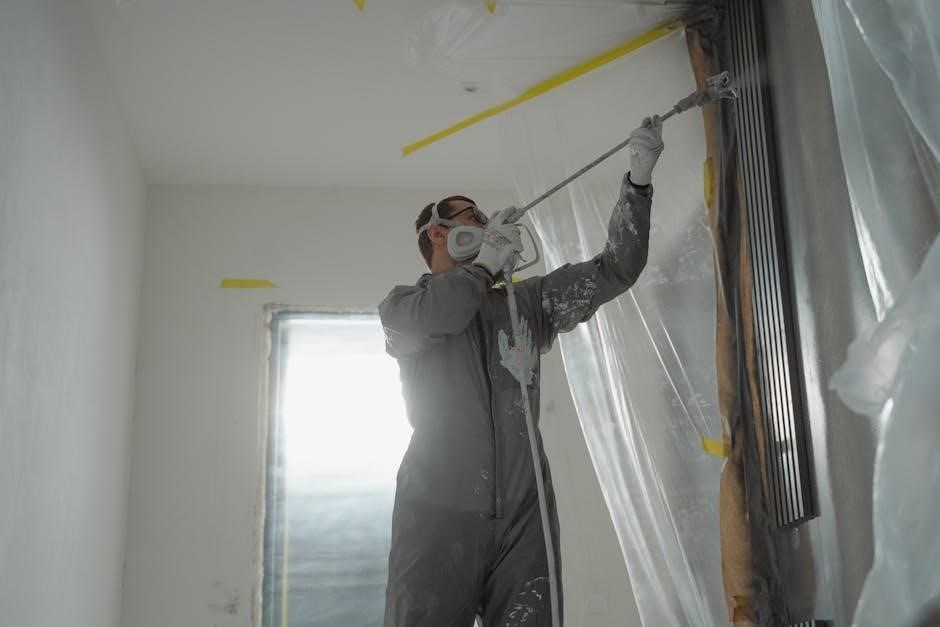Safe Work Permit PDF: A Comprehensive Guide
A comprehensive guide to safe work permits is essential for ensuring workplace safety and regulatory compliance. This guide provides crucial information about safe work permit processes, offering templates and forms for various work scenarios and environments.
What is a Safe Work Permit?
A safe work permit is a formal, documented authorization that outlines the necessary precautions and procedures for safely conducting specific tasks. It is a critical tool for managing workplace hazards, ensuring that all personnel involved are aware of the potential risks and the control measures in place. This document serves as a checklist and a record, helping to prevent accidents and injuries during high-risk activities.
Safe work permits are often required for tasks such as hot work, confined space entry, electrical work, and excavation. The permit details the job overview, potential hazards, required PPE, and necessary permits, streamlining the work authorization process and fostering a culture of safety and compliance within the workplace.
Definition and Purpose
A safe work permit is a written document authorizing specific work to be performed, ensuring that all associated hazards have been identified and controlled. Its primary purpose is to prevent workplace incidents by establishing a clear, documented process for high-risk activities. The permit outlines the job scope, potential hazards, control measures, and necessary personal protective equipment (PPE).
The purpose extends to ensuring that all personnel involved are informed about the risks and understand the procedures to mitigate them. By requiring a formal review and approval process, the permit system promotes communication, accountability, and a proactive approach to safety. Ultimately, it helps maintain a safe working environment, reducing the likelihood of accidents, injuries, and regulatory violations.
Importance of Safe Work Permits
Safe work permits are vital for maintaining a secure and healthy work environment, significantly reducing the risk of accidents and injuries; They ensure that all potential hazards are identified, assessed, and controlled before work commences, safeguarding employees and the facility. These permits enforce a structured approach to high-risk activities, promoting a culture of safety and accountability among workers.
Moreover, safe work permits facilitate better communication and coordination between different teams and departments, ensuring everyone is aware of the ongoing tasks and potential risks. By adhering to permit requirements, companies demonstrate compliance with occupational health and safety regulations, avoiding penalties and legal liabilities. The implementation of effective permit systems enhances overall operational efficiency and protects the organization’s reputation.

Key Elements of a Safe Work Permit
A safe work permit incorporates job overviews, hazard identification, control measures, required personal protective equipment (PPE), and necessary permits. These elements ensure all aspects of the task are carefully considered and planned.
Job Overview
The job overview section in a safe work permit meticulously documents the specific task to be performed. This includes a detailed description of the work, tools, and equipment to be used, as well as any related activities. This component ensures that everyone involved is fully aware of the scope and nature of the job, fostering clarity and minimizing potential misunderstandings.
A clear job overview facilitates better planning and hazard identification, as well as the implementation of appropriate control measures. It also helps to verify that the right resources and personnel are allocated to the task, thus enhancing safety and efficiency. A well-defined job overview is the foundation for a safe and successful work execution, promoting a proactive approach to risk management and adherence to safety protocols throughout the work process.
Hazard Identification
Hazard identification is a critical element within a safe work permit, focusing on identifying potential dangers associated with the job. This process involves a thorough review of the work environment and task details to pinpoint any risks. This step is crucial for ensuring that all potential hazards are recognized and addressed before work commences.
Common hazards include physical dangers, chemical exposures, electrical risks, and confined spaces. Identifying these hazards allows for the implementation of appropriate control measures, such as engineering controls, administrative procedures, and personal protective equipment. By proactively recognizing and mitigating hazards, the risk of accidents and injuries is significantly reduced, creating a safer work environment for everyone involved in the task.
Control Measures
Control measures are vital in a safe work permit, outlining specific actions to mitigate identified hazards. These measures aim to reduce the risk of incidents by implementing strategies that protect workers. Effective control measures are essential for creating a safe working environment and preventing potential harm.
Common control measures include engineering controls, such as machine guarding and ventilation systems, which physically isolate workers from hazards. Administrative controls, such as safe work procedures and training programs, also play a significant role. Personal protective equipment (PPE), including gloves, goggles, and respirators, offers additional protection. Implementing a combination of these controls ensures comprehensive safety, minimizing the likelihood of accidents and promoting a healthier workplace by addressing hazards effectively.

Personal Protective Equipment (PPE)
Personal Protective Equipment (PPE) is a crucial element within a safe work permit, acting as the last line of defense against workplace hazards. PPE includes items like safety glasses, gloves, hard hats, and respirators, which are selected based on the specific risks involved in the job. It is essential to ensure that all workers have access to and properly use the required PPE.
Effective PPE usage requires proper training, ensuring that employees understand how to wear, maintain, and inspect their equipment. Regular inspections of PPE help identify any damage or wear, ensuring that it functions correctly when needed. Furthermore, the safe work permit should clearly state the specific PPE required for each task, promoting a culture of safety and minimizing potential injuries by providing essential protection.
Required Permits
Identifying the necessary permits is an integral part of a safe work permit system, ensuring compliance and safety. Depending on the job’s nature, several permits might be required, such as hot work permits, confined space entry permits, or electrical work permits. Each permit addresses specific hazards and outlines control measures.
The safe work permit should clearly list all required permits, ensuring that no critical authorization is overlooked. This process involves verifying that all necessary documentation is completed and approved before work begins. Obtaining the correct permits ensures that competent personnel have assessed the risks, implemented appropriate safety measures, and authorized the work. Failing to secure the required permits can lead to severe safety breaches and regulatory penalties, emphasizing their importance.

Types of Work Permits
Different work environments and tasks necessitate specific permits to ensure safety; Common types include hot work, cold work, confined space entry, excavation, and electrical work permits, each addressing unique risks.
Hot Work Permit

A hot work permit is required for any task involving open flames, sparks, or heat that could potentially ignite flammable materials. This includes activities like welding, cutting, grinding, and brazing. The permit ensures that precautions are taken to prevent fires and explosions, such as removing flammable materials from the area, providing fire extinguishing equipment, and designating a fire watch.
The hot work permit details the specific tasks to be performed, the potential hazards involved, and the control measures to mitigate those hazards. Proper ventilation, use of personal protective equipment (PPE), and continuous monitoring are also essential components. Issuance requires trained personnel and a thorough risk assessment to minimize potential incidents.
Cold Work Permit

A cold work permit applies to tasks that do not involve heat or ignition sources. These tasks might include mechanical repairs, inspections, or cleaning activities. While not involving flames, cold work can still present hazards like confined spaces, chemical exposure, or moving machinery. The permit verifies that these risks are assessed and controlled.
The cold work permit outlines the specific job, potential hazards, and necessary precautions. This might involve lockout/tagout procedures, use of PPE, and ensuring proper ventilation. The permit ensures all workers are aware of the potential dangers and have the tools and knowledge to perform the job safely. Regular reviews and audits ensure ongoing compliance.
Confined Space Entry Permit
A confined space entry permit is required for any work within areas that are enclosed and pose potential hazards due to limited entry/exit. These spaces may contain dangerous atmospheres, lack oxygen, or have engulfment risks. The permit ensures a systematic approach to hazard assessment and control before entry.
The permit details the specific confined space, potential hazards, and required safety measures, such as atmospheric testing, ventilation, and standby personnel. It also confirms that rescue procedures are in place. All entrants must be trained and authorized, understanding the risks and emergency protocols. Regular drills help confirm readiness and proper usage of equipment. This permit is essential for protecting workers in hazardous environments.
Excavation Permit
An excavation permit is crucial for any digging or trenching work, aiming to prevent cave-ins, damage to underground utilities, and other hazards. Before any excavation begins, a thorough site assessment is conducted to identify potential risks, including soil stability, existing underground lines, and nearby structures. The permit outlines the scope of the excavation, necessary safety precautions, and emergency procedures.
Workers must be trained in safe excavation practices, including shoring techniques and the use of protective systems. The permit also specifies the requirements for inspecting the excavation daily to ensure ongoing stability and safety. Clear communication protocols are established to address any unexpected findings or changes during the excavation process. This permit is fundamental for protecting workers and preventing property damage during excavation activities.
Electrical Work Permit
An electrical work permit is essential for any task involving electrical systems or equipment, aiming to prevent electric shock, arc flash, and other electrical hazards. Before commencing work, a qualified electrician must assess the situation, identifying potential risks and necessary precautions. The permit details the specific electrical work to be performed, including de-energization procedures, lockout/tagout requirements, and personal protective equipment (PPE) needed.
Workers must be trained in safe electrical work practices and familiar with relevant safety standards. The permit also specifies the need for using appropriate testing equipment to verify the absence of voltage before starting work. Clear communication protocols are established to coordinate with other workers in the area and prevent accidental energization. This permit is vital for ensuring the safety of electricians and preventing electrical incidents during maintenance, repairs, or installations.

The Safe Work Permit Process
The safe work permit process involves several critical steps, including hazard review, site inspection, clear communication, proper notification, and diligent permit closure. Following these steps ensures a safer work environment.

Reviewing Hazards
Reviewing hazards is a fundamental step in the safe work permit process, crucial for identifying potential dangers before work begins. This involves a thorough assessment of the job site to pinpoint any existing or potential hazards related to the task. The review should consider factors such as the nature of the work, equipment used, environmental conditions, and proximity to other operations.
A comprehensive hazard review typically includes examining generic hazards lists, consulting with experienced personnel, and analyzing past incidents to learn from previous mistakes. The goal is to identify all possible risks, from physical dangers to health hazards, ensuring that no potential threat is overlooked. Documenting these hazards is important for creating effective control measures and communicating risks to all involved personnel. This initial review sets the foundation for a safer work environment by enabling proactive risk management and preventing accidents before they occur.
Site Inspection
A site inspection is a critical component of the safe work permit process, involving a physical examination of the work area to confirm identified hazards and assess existing conditions. This inspection is typically conducted by competent personnel before the commencement of any work activities. The primary objective is to verify that all potential hazards identified during the hazard review are accurately recognized and understood in the context of the actual work environment.
During the site inspection, inspectors should observe the physical layout, environmental factors, and the presence of any pre-existing conditions that could impact safety. This includes checking equipment, ensuring proper ventilation, and verifying the stability of structures. Any discrepancies between the documented hazards and the actual site conditions must be addressed and documented, ensuring that control measures are adapted accordingly. The site inspection serves as a final check to ensure that the work area is safe and prepared for the planned activities.
Communication and Notification
Effective communication and notification are paramount to the safe work permit process, ensuring that all involved parties are aware of the planned work, associated hazards, and necessary precautions. This involves informing relevant personnel, including workers, supervisors, and emergency responders, about the scope of the work, potential risks, and control measures in place. Clear and concise communication helps prevent misunderstandings and ensures that everyone is prepared to address any unforeseen issues that may arise.
Notification procedures should specify who needs to be informed, how they will be notified, and what information they need to receive. This may include pre-work briefings, documented notifications, and the posting of permits in visible locations. Regular communication throughout the duration of the work is also essential, allowing for updates on progress, changes in conditions, and any new hazards that are identified. Proper communication and notification foster a culture of safety, where everyone is informed and empowered to take appropriate action.
Permit Closure
The permit closure process is a critical step in the safe work permit system, ensuring that all work has been completed safely and the work area is returned to a safe condition. This involves a final inspection of the work site to verify that all tools, equipment, and materials have been removed, and that any safety devices or guards have been reinstalled. The person responsible for the work must confirm that the job has been completed according to the permit requirements and that all personnel have left the area.
The closure process also includes a review of the permit to identify any lessons learned or areas for improvement. Any problems encountered during the job should be documented, and the permit should be signed off by the authorized personnel. The closed permit serves as a record of the work performed and the safety measures taken, providing valuable information for future planning and risk assessment. Proper permit closure ensures accountability and continuous improvement in safety practices.

Safe Work Permit Templates and Forms
Streamline work authorization with user-friendly templates, ensuring safety and compliance. These templates cover various permits, including hot work and confined space entry. Download them to enhance your workplace safety protocols.
General Work Permit Template

A General Work Permit template streamlines the authorization process for various non-hazardous tasks. It covers the entire Permit to Work System, ensuring employees are aware of necessary procedures before commencing work. This template focuses on identifying potential hazards and implementing appropriate control measures to mitigate risks. It includes sections for job overview, hazard identification, required PPE, and necessary permits, promoting a safe work culture.
This versatile template assists in documenting essential information, ensuring compliance with safety regulations. By utilizing a General Work Permit template, organizations can standardize their work authorization process, reducing the likelihood of accidents and promoting a safer work environment for all employees involved. This template serves as a crucial tool for maintaining workplace safety.
Hot Work Permit Form
The Hot Work Permit form specifically addresses tasks involving potential ignition sources, such as welding, cutting, and grinding. It ensures that all necessary precautions are taken to prevent fires or explosions during hot work activities. This form supplements the General Work Permit, granting approved personnel permission to perform hot work safely.
The Hot Work Permit form includes detailed sections for hazard assessment, fire prevention measures, and required personal protective equipment (PPE). It also mandates a thorough site inspection to identify and mitigate any potential fire hazards before work begins. Proper completion and adherence to the Hot Work Permit form are critical for ensuring a safe work environment during hot work operations, minimizing risks of accidents and injuries for all personnel.
Confined Space Entry Form
The Confined Space Entry Form is a crucial document for safely managing entry into spaces with limited access and potential hazards. This form ensures a structured approach to identify, assess, and control risks associated with confined spaces, such as oxygen deficiency, toxic gases, or engulfment hazards. It complements the General Work Permit by providing specific guidance for confined space entry.
The form includes sections for atmospheric testing, ventilation requirements, and emergency rescue procedures. It mandates continuous monitoring of the atmosphere within the confined space and requires the presence of a trained attendant outside the space. Proper use of the Confined Space Entry Form is vital for protecting workers from the unique dangers associated with confined spaces, ensuring compliance with safety regulations and preventing potentially fatal accidents.